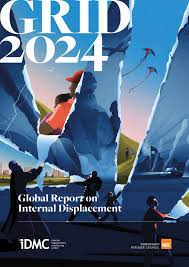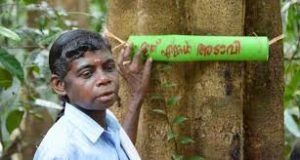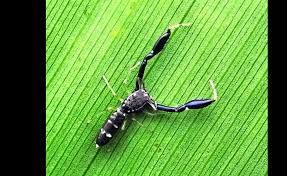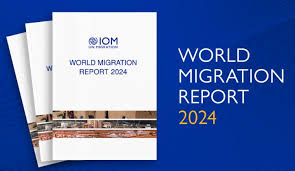Today’s Current Affairs: 17th May 2024 for UPSC IAS exams, State PSC exams, SSC CGL, State SSC, RRB, Railways, Banking Exam & IBPS, etc
Table of Contents
Global Report On Internal Displacement 2024:

The number of internally displaced people increased to 75.9 million, from 71.1 million in the preceding year, according to the Global Report on Internal Displacement 2024 (GRID-2024) released recently.
- Global Report on Internal Displacement 2024 is an annual report published by the Geneva-based Internal Displacement Monitoring Centre (IDMC). It records internal displacements due to conflict and violence and disasters.
Highlights of GRID-2024 :
- The number of internally displaced people (IDP) increased to 75.9 million, from 71.1 million in the preceding year.
- Report says 7.7 million displaced by disasters (one-fourth of it was caused by earthquakes) and 68.3 million by conflict and violence.
- Sudan, Syria, the Democratic Republic of the Congo (DRC), Colombia, and Yemen host nearly half of the world’s IDPs.
- At 1 million, Sudan has the highest number of IDPs recorded for a single country.
- Most of the new displacement this year happened in Sudan, the Palestinian territories, and the Democratic Republic of Congo, accounting for almost two-thirds of all new displacement.
- The IDMC said around 3 million people were living in internal displacement as a result of conflict and violence across South Asia at the end of 2023, 80 percent of whom were in Afghanistan.
- Conflict and violence triggered 69,000 displacements in South Asia in 2023, with Manipur violence alone accounting for 67,000.
- It is the highest number of displacements triggered by conflict and violence in India since 2018.
- There is a sharp decline in IDP in 2023 from 2.5 million internal displacements due to natural disasters in India in 2022. Internal displacements by natural disasters in 2023 was 528,000.
Insurance Surety Bonds:

Insurance companies have issued about 700 insurance surety bonds valued about ₹3,000 crore after Centre makes the instrument on par with bank guarantees for all government procurements.
- Surety Bond is a promise to be liable for the debt, default, or failure of another.
- It is a three-party contract in which one party (the surety) guarantees the performance or obligations of a second party (the principal) to a third party (the obligee).
- Insurance Surety Bonds is a financial instrument, where insurance companies act as ‘Surety’ and provides the financial guarantee that the contractor will fulfil its obligation as per the agreed terms.
- It is a risk transfer mechanism wherein an insurer provides a guarantee to a beneficiary or obligee that the principal or contractor will meet his contractual obligations.
- In case the principal fails to deliver his promise, a monetary compensation is paid to the obligee by the insurer.
- There are 3 parties involved:
- The Surety (Insurance Companies) will provide the financial guarantee to the Obligee /beneficiary.
- Obligee or Beneficiary (example-Government, Infrastructure Development Authorities etc.) -the party that needs the surety and is often the beneficiary of the surety bond.
- Principal (could be the owner or contractor)-the party that purchases the Surety bond from an insurer as a guarantee and undertakes a commitment to perform the obligations as per the contract entered.
Bulava Missile:

Russian President has bolstered the country’s military capabilities by ordering the addition of a new nuclear-capable missile known as the Bulava into the Russian military arsenal.
- RSM-56 Bulava (NATO reporting name: SS-N-32) is a Russian submarine-launched intercontinental ballistic missile (ICBM).
- Designed by the Moscow Institute of Thermal Technology, development of the missile was launched in the late 1990s, and is designed to be deployed on Russia’s Borei-class submarines.
- Bulava represents a core component of Russia’s future strategic nuclear force.
- It is a three-stage solid-propellant
- The missile has a launch mass of about 8 tonnes and a throw weight of 1,150 kg.
- It measures 12.1 meters in length in a launch container and 2 meters in diameter.
- Bulava has a maximum range of 8,300 km (5,160 miles) and a payload of up to 10 multiple independently targetable re-entry vehicles, or MIRVs, capable of delivering nuclear warheads to different targets.
- The missile’s RVs are capable of in-flight maneuverability and re-targeting to out maneuver any enemy defense.
- The RVs have an expected accuracy of around 250 to 300 m.
Kadars:

The recent death of a Kadar tribesman in Tamil Nadu’s Anamalai Tiger Reserve in an elephant attack has left the indigenous community and conservationists in shock as Kadars are known to co-exist with wild elephants for ages.
- They are a small indigenous tribal community in South India.
- They reside along the hilly border between Cochin in Kerala and Coimbatore in Tamil Nadu.
- They are traditional forest dwellers who depend on forest produce for sustenance. They do not practice agriculture, building shelters thatched with leaves and shifting locations as their employment requires.
- They prefer to eat rice obtained in a trade or as wages rather than to subsist on food of their own gathering.
- They have long served as specialized collectors of honey, wax, sago, cardamom, ginger, and umbrella sticks for trade with merchants from the plains.
- They have a symbiotic relationship with nature, and they believe in the coexistence of Kadar and Kaadu (forest).
- The Kadar have traditional protocols to ensure the sustainable use of forest resources.
Ligdus Garvale : New Spider Species

A team of naturalists recently documented a new spider species named ‘Ligdus Garvale’ from Garvale, a village nestled in the Somwarpet taluk of the Kodagu district, Karnataka.
- Ligdus Garvale is a new species of jumping spider. It marks only the second recorded instance of the Ligdus genus in 129 years.
- It was found in Garvale village of the Kodagu district, Karnataka, which is surrounded by agroforestry, with coffee plantations being prominent along with pepper and paddy fields.
- It was discovered under the leaf of a torch ginger plant and bears a resemblance to Pseudoscorpions.
- Due to its nature as a high canopy jumper, it often goes unnoticed and constructs a double-layered web for retreat.
- Jumping spiders are the largest family of spiders, with more than 6,380 species (family Salticidae). They are known for their ability to jump and pounce upon their prey.
- They are very common in the tropics, but some also live in northern and even Arctic regions.
Global Trade Update 2024:

The United Nations Conference on Trade and Development (UNCTAD) has released its Global Trade Update 2024, which highlights that, after facing declines over several quarters, international trade is poised for a rebound in 2024.
- UNCTAD has officially rebranded as “UN Trade and Development” as part of its 60th-anniversary celebrations.
- The organisation will adopt its new name and logo across all official channels, including communication materials in the six official languages of the United Nations.
Key Highlights of the Global Trade Update:
- Global trade dipped 3% to USD 31 trillion in 2023 after peaking in 2022.
- The downturn was driven by less demand in developed economies and weaker trade in East Asia and Latin America.
- The downturn was driven by a 5% fall in trade in goods. Meanwhile, trade in services bucked the negative trend, growing by 8%.
- The sector was fuelled by a nearly 40% surge in tourism and travel-related services.
- Developing countries experienced a sharper decline in trade, with their imports and exports falling by 5% and 7%, respectively, compared to a 4% drop in imports and 3% in exports for developed nations.
- Most regions saw negative trade growth in 2023.
- The exception was a significant increase in intra-regional trade in Africa.
- Despite the overall decline, 2023 saw a 2% rise in trade for environmental products, driven primarily by soaring Electric Car sales. E.g. Trade in electric vehicles grew by 60%.
- The final quarter of 2023 brought signs of stabilisation, particularly in developing regions.
- Most sectors saw a rebound, although trade in apparel (clothing and clothing accessories) continued to contract, falling by 13%.
World Hydrogen Summit 2024:

The Indian Pavilion, organised by the Ministry of New and Renewable Energy, stands as one of the largest at the esteemed World Hydrogen Summit 2024 in Rotterdam, Netherlands. It serves as a platform to showcase the nation’s notable advancements in green hydrogen.
- India launched the National Green Hydrogen Mission (NGHM) in January 2023 with a budget of Rs. 19,744 crores.
- The mission aims to achieve a green hydrogen production capacity of 5 MMT (Million Metric Tonnes) by 2030. Currently, tenders have been awarded for setting up 412,000 tonnes of Green Hydrogen production capacity and 1,500 MW of electrolyzer manufacturing capacity.
- Under NGHM a dedicated portal was launched to provide information on the mission and steps for developing the green hydrogen ecosystem in India.
- India has also released scheme guidelines for the use of Green Hydrogen in steel, transport, and shipping sectors.
- The Department of Science and Technology has initiated Hydrogen Valley Innovation Clusters to foster innovation and promote the green hydrogen ecosystem in India.
World Migration Report 2024:

The World Migration Report 2024 was launched by the International Organization for Migration (IOM), revealing significant shifts in global migration patterns. World Migration Report is IOM’s flagship report released biennially.
- The report highlighted that Mexico, China, the Philippines, and France were the other four nations in the top five remittance recipient countries, with India being the top country receiving remittances in 2010, 2015, 2020, and 2022.
- International remittances increased by 650% from USD 128 billion to USD 831 billion between 2000 and 2022 with India receiving the highest remittances at USD 111 billion in 2022 followed by Mexico.
- USD 647 billion of the total remittances were sent by migrants to low- and middle-income countries.
- Despite remittances acting as a crucial source of income for many South Asians, migrant workers from the region remain vulnerable to various challenges.
- These challenges include financial exploitation, excessive debt incurred due to migration costs, xenophobia (hostility towards foreigners), and workplace abuses.
- The number of displaced people hit a record high by the end of 2022 at 117 million.
- India is the origin of the largest number of international migrants in the world (nearly 18 million), with large diasporas in countries like the UAE, the US, and Saudi Arabia.
- According to the report, India has a slightly higher share of female immigrants than males. Countries with a significantly high proportion of male emigrants include India, Bangladesh and Pakistan.
- Gulf Cooperation Council (GCC) countries remain significant destinations for migrant workers, especially from India, Egypt, Bangladesh, Ethiopia, and Kenya, employed in sectors like construction, hospitality, security, domestic work, and retail.
GPT-4o : OpenAI

OpenAI has introduced GPT-4o, its newest and most advanced AI model, designed to enhance ChatGPT by making it smarter, faster, and free for all users.
- GPT-4o this model, named “Omni,” represents a significant upgrade from previous models by supporting multimodal interactions—processing and responding to text, audio, and images.
- Unlike its predecessors, which used separate models for different tasks, GPT-4o integrates all functionalities into a single model, improving efficiency and response speed.
- GPT-4o’s capabilities include real-time translations, emotion detection in audio, and understanding and interacting with visual inputs like screenshots and documents.
- It also offers multilingual support and better performance with non-English texts, aiming to be more accessible globally.
- The technology behind GPT-4o enables holistic understanding of inputs, considering factors like tone and background noise.
- Its response times are remarkably fast, between 232 to 320 milliseconds.
- Safety measures include filtered training data and post-training model refinement to address risks like misinformation and bias.
Semal Trees:

Semal trees, crucial to Udaipur’s Holi festivities, face peril in south Rajasthan. Despite their ecological significance, thousands are cut annually for bonfires, violating forest laws.
- Semal trees, also known as silk cotton trees or Bombax Ceiba, are large, fast-growing trees (large deciduous trees, known for their Crimson red flowers) native to India. Ayurvedic medicines can be prepared from every part of the tree (e.g., roots are used for treating ailments such as diabetes, etc).
- It is worshipped by many tribal communities in Rajasthan (e.g. Garasia tribe, Kathodi tribe) and Madhya Pradesh.
- Its seed produces edible oil, used in making soaps. Semal plays a crucial role in the forest ecosystem, providing habitat and food for various species, including rock bees, moths, sparrows, and bugs.
- Additionally, tribal communities rely on Semal for food, crafting, and cultural beliefs.
India Proposes Digital Competition Bill, 2024 Against Tech Giants:

The government has proposed the Digital Competition Bill, 2024 taking a clue from European regulatory frameworks This draft law aims to regulate the operations of major technology firms such as Google, Facebook, and Amazon, ensuring they do not misuse their dominant positions.
- This proposal seeks to prevent these corporations from favouring their services over competitors’ and misusing data to benefit their various business segments.
- The Bill introduces a proactive regulatory approach (ex-ante), which anticipates and prevents anti-competitive practices before they occur, unlike the reactive (ex post) framework under the current Competition Act, 2002.
- The Bill proposes identifying Systematically Significant Digital Enterprises (SSDEs) based on criteria like turnover, user base, and market influence. These SSDEs will be restricted from certain practices such as self-preferencing and anti-steering.
- The legislation also plans to regulate ADEs which benefit from data shared within their group companies, ensuring that their operations do not undermine competitive practices.
Hepatitis A Outbreak : Kerela

There has been a big spread of Hepatitis A in Kerala’s Malappuram district, with about 8,000 cases and 12 deaths.
- The virus, which is known for being very contagious, usually affects kids younger than 15 years old, but it is now spreading to older people whose immune systems aren’t working as well.
- Hepatitis A is a liver infection caused by a highly contagious virus.
- Infected individuals can show symptoms such as jaundice, fever, and stomach pain.
- Symptoms typically appear between two to six weeks after contracting the virus.
- In 99% of cases, the infection goes away on its own and does not damage the liver permanently.
- Severe outcomes like liver failure or death are rare.
- Transmission of the Virus
- The main way the Hepatitis A virus gets from feces to mouth is through contaminated food or water.
- It can be found in the poop of an infected person before they even show any signs, and it can still be found after symptoms have gone away.
- Past cases, like those in Delhi and Kanpur, were caused by broken sewer lines and letting dirty water into the water supply.
- Symptoms:
- Some common signs are feeling sick, having a different color of pee, and having stomach pain.
- In the worst cases, it can cause tiredness, loss of awareness, and bleeding.
Fatah-II Rocket : Pakistan

Pakistan did a successful test launch of the “Fatah-II” guided multi-launch rocket system.
- Pakistan’s weaponry is getting better, and this event is a big step in that direction.
- The Fatah-II rocket system was made to hit targets up to 400 kilometers away with great accuracy.
- It can get around and get past missile defense systems because it has a sophisticated tracking system and a unique ability to change its path and move around.
- Fatah-II to Pakistan’s artillery divisions is meant to improve the army’s ability to hit faraway targets with pinpoint accuracy.
- It is expected that this induction will greatly improve the destructive power and range of the country’s conventional military assets.
- Senior army officials, scientists, and engineers watched the flight test of the Fatah-II rocket system to make sure it went well and efficiently.
- After the launch went well, President Asif Ali Zardari, Prime Minister Shehbaz Sharif, and top military officers praised the troops and scientists who worked on it.
- They did this to show how important this military technology advance was to the whole country.




